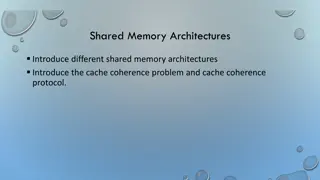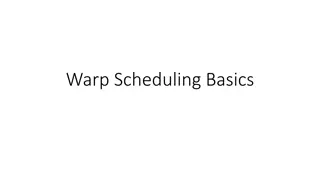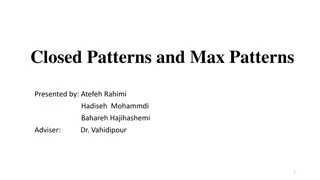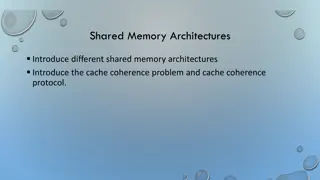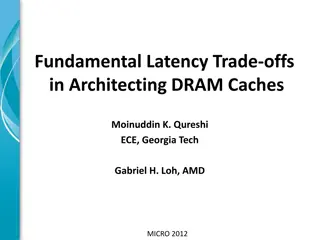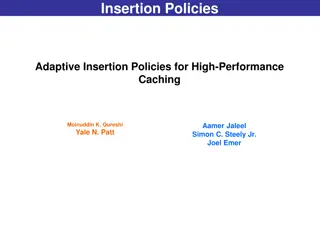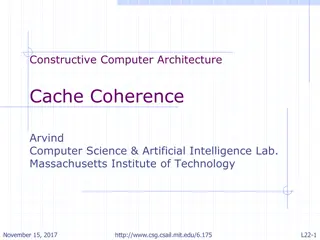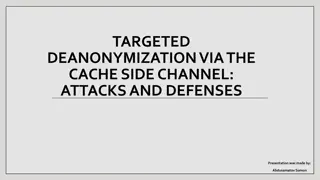Cache Examples and Access Patterns
Today's lecture covers cache access, problems in cache design, and caching policies. Examples include direct-mapped cache, tag arrays, access patterns, line size impact, and associativity. Explore how cache hits and misses are affected based on address requests. Learn about set-associative cache design and its impact on cache performance.
Uploaded on Feb 17, 2025 | 0 Views
Download Presentation

Please find below an Image/Link to download the presentation.
The content on the website is provided AS IS for your information and personal use only. It may not be sold, licensed, or shared on other websites without obtaining consent from the author.If you encounter any issues during the download, it is possible that the publisher has removed the file from their server.
You are allowed to download the files provided on this website for personal or commercial use, subject to the condition that they are used lawfully. All files are the property of their respective owners.
The content on the website is provided AS IS for your information and personal use only. It may not be sold, licensed, or shared on other websites without obtaining consent from the author.
E N D
Presentation Transcript
Lecture 23: Cache Examples Today s topics: Cache access Example problems in cache design Caching policies 1
Accessing the Cache Byte address 101000 Offset 8-byte words 8 words: 3 index bits Direct-mapped cache: each address maps to a unique location in cache Sets Data array 3
The Tag Array Byte address 101000 Tag 8-byte words Compare Direct-mapped cache: each address maps to a unique address Tag array Data array 4
Example Access Pattern Byte address Assume that addresses are 8 bits long How many of the following address requests are hits/misses? 4, 7, 10, 13, 16, 68, 73, 78, 83, 88, 4, 7, 10 101000 Tag 8-byte words Compare Direct-mapped cache: each address maps to a unique address Tag array Data array 5
Increasing Line Size A large cache line size smaller tag array, fewer misses because of spatial locality Byte address 10100000 32-byte cache line size or block size Tag Offset Tag array Data array 6
Associativity Set associativity fewer conflicts; wasted power because multiple data and tags are read Byte address 10100000 Tag Way-1 Way-2 Tag array Data array Compare 7
Associativity How many offset/index/tag bits if the cache has 64 sets, each set has 64 bytes, 4 ways Byte address 10100000 Tag Way-1 Way-2 Tag array Data array Compare 8
Example 1 32 KB 4-way set-associative data cache array with 32 byte line sizes How many sets? How many index bits, offset bits, tag bits? How large is the tag array? Cache size = #sets x #ways x blocksize Index bits = log2(sets) Offset bits = log2(blocksize) Addr width = tag + index + offset 9
Example 1 32 KB 4-way set-associative data cache array with 32 byte line sizes cache size = #sets x #ways x block size How many sets? 256 How many index bits, offset bits, tag bits? 8 5 19 log2(sets) log2(blksize) addrsize-index-offset How large is the tag array? tag array size = #sets x #ways x tag size = 19 Kb = 2.375 KB 10
Example 2 Show how the following addresses map to the cache and yield hits or misses. The cache is direct-mapped, has 16 sets, and a 64-byte block size. Addresses: 8, 96, 32, 480, 976, 1040, 1096 Offset = address % 64 (address modulo 64, extract last 6) Index = address/64 % 16 (shift right by 6, extract last 4) Tag = address/1024 (shift address right by 10) 32-bit address 22 bits tag 4 bits index 6 bits offset 8: 0 0 8 M 96: 0 1 32 M 32: 0 0 32 H 480: 0 7 32 M 976: 0 15 16 M 1040: 1 0 16 M 1096: 1 1 8 M . . . 11
Example 3 A pipeline has CPI 1 if all loads/stores are L1 cache hits 40% of all instructions are loads/stores 85% of all loads/stores hit in 1-cycle L1 50% of all (10-cycle) L2 accesses are misses Memory access takes 100 cycles What is the CPI? 12
Example 3 A pipeline has CPI 1 if all loads/stores are L1 cache hits 40% of all instructions are loads/stores 85% of all loads/stores hit in 1-cycle L1 50% of all (10-cycle) L2 accesses are misses Memory access takes 100 cycles What is the CPI? Start with 1000 instructions 1000 cycles (includes all 400 L1 accesses) + 400 (ld/st) x 15% x 10 cycles (the L2 accesses) + 400 x 15% x 50% x 100 cycles (the mem accesses) = 4,600 cycles CPI = 4.6 13
Example 4 Assume that addresses are 8 bits long How many of the following address requests are hits/misses? 4, 7, 10, 13, 16, 24, 36, 4, 48, 64, 4, 36, 64, 4 Byte address 00010000 Tag Way-1 Way-2 8-byte blocks Tag array Data array 14
Example 4 Assume that addresses are 8 bits long How many of the following address requests are hits/misses? 4, 7, 10, 13, 16, 24, 36, 4, 48, 64, 4, 36, 64, 4 M H M H M M M H M M H M M M Byte address 00010000 Tag Way-1 Way-2 8-byte blocks Tag array Data array 15
Cache Misses On a write miss, you may either choose to bring the block into the cache (write-allocate) or not (write-no-allocate) On a read miss, you always bring the block in (spatial and temporal locality) but which block do you replace? no choice for a direct-mapped cache randomly pick one of the ways to replace replace the way that was least-recently used (LRU) FIFO replacement (round-robin) 16
Writes When you write into a block, do you also update the copy in L2? write-through: every write to L1 write to L2 write-back: mark the block as dirty, when the block gets replaced from L1, write it to L2 Writeback coalesces multiple writes to an L1 block into one L2 write Writethrough simplifies coherency protocols in a multiprocessor system as the L2 always has a current copy of data 17
Types of Cache Misses Compulsory misses: happens the first time a memory word is accessed the misses for an infinite cache Capacity misses: happens because the program touched many other words before re-touching the same word the misses for a fully-associative cache Conflict misses: happens because two words map to the same location in the cache the misses generated while moving from a fully-associative to a direct-mapped cache 18



